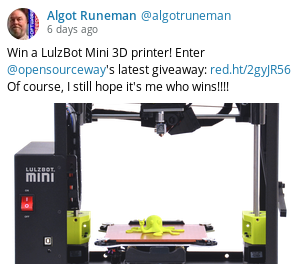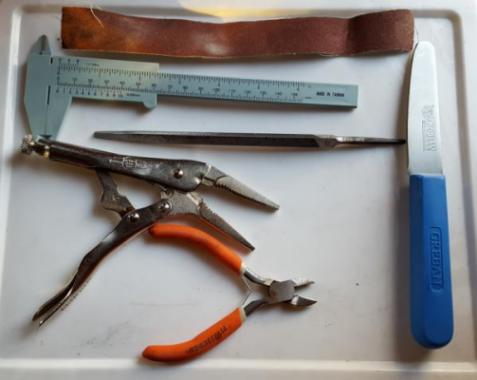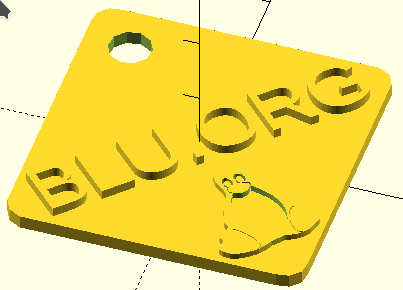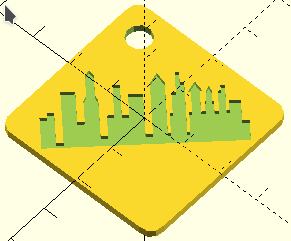
The winning entry
3D Printing
A presentation for the Boston Linux/Unix User Group on 11/15/2017.
Slides: [LINK]
The slides need no special software. The slides are done in HTML (Eric Meyer's S5 Slideshow System)
Good fortune presented me with a new hobby. Opensource.com and Lulzbot arranged a contest on Twitter. All that was needed was a tweet about the contest, spreading the word about the contest, and simultaneously entering it.
The Process:
Heat a plastic filament and squeeze (extrude) it through a nozzle while moving the nozzle head carefully around in a flat plane. Then move up a very thin layer and repeat to gradually build an object in three dimensions.
X,Y and Z are the letters which we typically use to describe the three dimensions. Additive Manufacturing and Fused Filament Fabrication (FFF) are two commonly seen terms when reading about 3D printing.
Free Software (AKA "open source") liberates me to create without needing to lock down my work in a proprietary format.
I have been using OpenSCAD (Pronounced "Open Ess-CAD") to do my 3D designs. It is described as a "parametric" design tool. That means it is possible to do a design with variables to determine sizes. That is familiar territory for programmers. For 3D design, it means many shapes can be conveniently resized. There is also an internal scale() function which allows changing the overall size of a design in three dimensions, but that's not quite the same thing. The term parametric applies in engineering so that objects are exactly aligned with others which conform to the same parameters. That makes 3D printing great for making replacement plastic parts or for design and quick testing and adjustment of new parts.
Tools: I have found that some small tools are helpful. The blue handled knife has a lightly serrated edge to lift objects from the print bed. It came with the printer along with a pair of bent tweezers which are great for removing occasional excess filament dangling from the HOT extruder.
I added roll sandpaper typically sold for wood lathe work and a triangular file to remove inevitable "hanging threads" and such. A pliers helps remove support structures and can also snap away objects from the print surface. The nippers help with prepping the filament. I saw a common flat chisel recommended for lifting prints off the bed. To stick PLA components together, superglue is good.



The keychain fob OpenSCAD design file and the STL print file are for you to reuse, as you wish. They are GPL-3 licensed.
(0.43 meters of filament each ≅ 3 grams - less than 10 cents each)
Other References
- Article - Lulzbot asked me to write about my prize
- Algot's Published Designs - with design notes
- Thingiverse - wide-ranging printable designs
- Sculpteo - one of many online printing services
- Look in! - watch the printer at work...sometimes. (guest/guest) Server Push Mode
- Comparing Slicer Software - for 3D printers